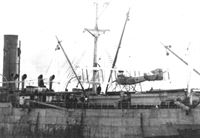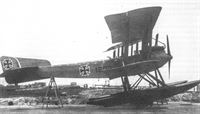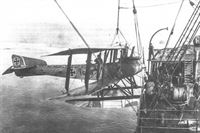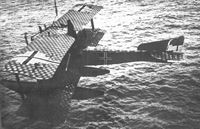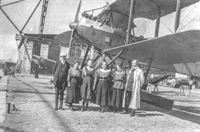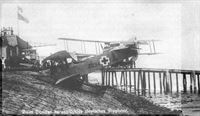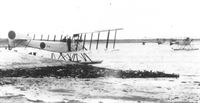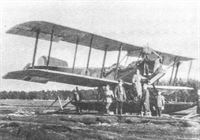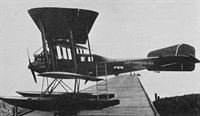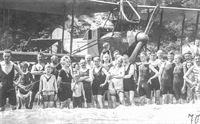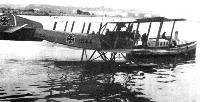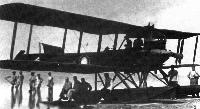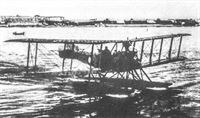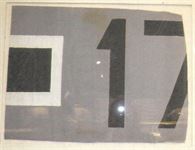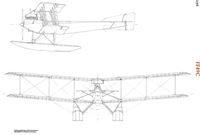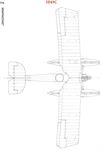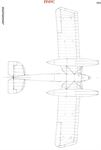
Описание
Страна: Германия
Год: 1917
Варианты
- Friedrichshafen - FF19 - 1914 - Германия
- Friedrichshafen - FF29 - 1914 - Германия
- Friedrichshafen - FF33 - 1915 - Германия
- Friedrichshafen - FF39 - 1916 - Германия
- Friedrichshafen - FF49 - 1917 - Германия
- Friedrichshafen - FF59 - 1918 - Германия
- Friedrichshafen - FF67 - 1918 - Германия
- Friedrichshafen - FF71 - 1919 - Германия
- В.Обухович, А.Никифоров Самолеты Первой Мировой войны
- O.Thetford, P.Gray German Aircraft of the First World War (Putnam)
- J.Stroud European Transport Aircraft since 1910 (Putnam)
- J.Herris Friedrichshafen Aircraft of WWI (A Centennial Perspective on Great War Airplanes 21)
- J.Forsgren Swedish Military Aircraft 1911-1926 (A Centennial Perspective on Great War Airplanes 68)
- M.Dusing German Aviation Industry in WWI. Volume 2 (A Centennial Perspective on Great War Airplanes 85)
- А.Александров, Г.Петров Крылатые пленники России
- E.Hauke, W.Schroeder, B.Totschinger Die Flugzeuge der k.u.k. Luftfahrtruppe und Seeflieger 1914-1918
- Журнал Flight
-
J.Herris - Friedrichshafen Aircraft of WWI /Centennial Perspective/ (21)
FF49C MN 1699 in late 1917 featured additions to its late-style camouflage.
-
J.Herris - Friedrichshafen Aircraft of WWI /Centennial Perspective/ (21)
FF49C MN 1756 in late 1918; the two diagonal stripes indicate assignment to Norderney. The final digit in the MN is not confirmed.
-
J.Herris - Friedrichshafen Aircraft of WWI /Centennial Perspective/ (21)
FF49C MN 1796 was forced down on 17 June 1918 while attacking HMS Furious and was the subject of an Allied report on the type. It was assigned to Helgoland SFS.
-
J.Herris - Friedrichshafen Aircraft of WWI /Centennial Perspective/ (21)
FF49C in civilian service postwar. The upper and side surfaces were covered in the late-war hexagonal naval camouflage fabric.
-
J.Herris - Friedrichshafen Aircraft of WWI /Centennial Perspective/ (21)
FF49C W7 in postwar Deutsche Luft Reederei (DLR) service. German airline DLR used 11 FF49C aircraft; W7 was later registered D-377.
-
J.Herris - Friedrichshafen Aircraft of WWI /Centennial Perspective/ (21)
FF49B of the Polish Naval Air Service, 1920.
-
J.Herris - Friedrichshafen Aircraft of WWI /Centennial Perspective/ (21)
FF49C in postwar Finnish service. MN 1810 was acquired from the former German base at Tallinn, Estonia on 26 Nov. 1918 and given serial 85/18, later changed to 2C 302 as shown here. It was deleted 25 May 1923 after 216 hours total flight time.
-
J.Herris - Friedrichshafen Aircraft of WWI /Centennial Perspective/ (21)
FF49C /FB II HM32 was one of five in Danish Naval Air Service postwar. These aircraft served until 1927 performing maritime reconnaissance.
-
J.Herris - Friedrichshafen Aircraft of WWI /Centennial Perspective/ (21)
FF49C MN 1682 in postwar Netherlands service as V4.
-
J.Forsgren - Swedish Military Aircraft 1911-1926 /Centennial Perspective/ (68)
Friedrichshafen FF49C '26' in Swedish service.
-
J.Herris - Friedrichshafen Aircraft of WWI /Centennial Perspective/ (21)
FF49C MN 1682 in postwar Swedish service.
-
J.Herris - Friedrichshafen Aircraft of WWI /Centennial Perspective/ (21)
FF49C Marine Number 1521 was the first Friedrichshafen built. The FF49C was a bigger, more powerful development of the FF33 series to perform the same tasks with better performance and heavier payload. Balanced upper ailerons reduced the pilot's workload on patrols while ailerons on all wings provided better maneuverability.
-
M.Dusing - German Aviation Industry in WWI. Volume 2 /Centennial Perspective/ (85)
Fdh FF49C (1917/18). On November 20, 1917, the first of a total of 238 FF49C aircraft took off. Despite its robust, almost cumbersome appearance, this new type had significant improvements over the FF39. Eventually, the FF49C became the Kaiserliche Marine's standard high-altitude reconnaissance aircraft. This type could remain in the air for almost 6 hours. It was built under license by Sablatnig, L.F.G. (Koslin) - 105 units, and also by Gotha at the end of 1918.
-
O.Thetford, P.Gray - German Aircraft of the First World War /Putnam/
Friedrichshafen FF 49 B
-
J.Herris - Friedrichshafen Aircraft of WWI /Centennial Perspective/ (21)
This FF49 aboard ship appears to be FF49B Marine Number 1608 or 1609 from the second batch of FF49B aircraft built. The aircraft is finished in the standard late-war camouflage scheme for German naval aircraft.
-
O.Thetford, P.Gray - German Aircraft of the First World War /Putnam/
Friedrichshafen FF 49c with Marine number 1602.
-
J.Herris - Friedrichshafen Aircraft of WWI /Centennial Perspective/ (21)
FF49C #1602 was one of a batch of 10 (1597-1606) ordered in June 1917 and carried standard late-war camouflage.
-
E.Hauke, W.Schroeder, B.Totschinger - Die Flugzeuge der k.u.k. Luftfahrtruppe und Seeflieger 1914-1918
Schwimmerflugzeug 1688, Type Friedrichshafen FF49C, Puntisella, Juli 1918; deutsche Postflugzeuge für die Betreuung der deutschen U-Boot-Besatzungen in Pola und Cattaro, ohne Bewaffnung von deutschen Fliegern betrieben, allerdings mit k.u.k. Markierungen
Гидросамолет 1688, тип Friedrichshafen FF49C, Пунтизелла, июль 1918 г .; Немецкие связные самолеты для обслуживания экипажей немецких подводных лодок в Пола и Каттаро, эксплуатируемые немецкими летчиками без вооружения, но с маркировкой k.u.k. -
J.Herris - Friedrichshafen Aircraft of WWI /Centennial Perspective/ (21)
FF49C #16X8 is being recovered by hoist. The FF49 was robust enough to withstand rough shipboard handling.
-
J.Herris - Friedrichshafen Aircraft of WWI /Centennial Perspective/ (21)
FF49C #1699 was first of a batch of 20 (1699-1718) ordered in August 1917 and carried a checkerboard marking.
The Friedrichshafen FF49c replaced the FF33 in production. The more powerful 200 hp Benz Bz.IV engine was fitted to achieve better performance and payload. The observer had a machine gun to defend against aerial attack. -
J.Herris - Friedrichshafen Aircraft of WWI /Centennial Perspective/ (21)
Nose details of FF49C #1699 that carries a checkerboard marking; the entire nose is painted dark (black?).
-
J.Herris - Friedrichshafen Aircraft of WWI /Centennial Perspective/ (21)
FF49C #175X carries a double white stripe unit marking. (Peter M. Bowers Collection/Museum of Flight)
-
A.Imrie - German Naval Air Service /Arms & Armour/
Beaching party, suitably attired in waterproof suits, bringing in Friedrichshafen FF49C 1778. When beaching did not allow seaplanes to run up the slipway to have the wheeled chassis fitted, the aircraft was stopped a few yards from the shore and the aircrew were taken off pick-a-back style; the handling crew then walked the machine on to the wheeled chassis and pulled the aircraft up the ramp out of the water.
-
J.Herris - Friedrichshafen Aircraft of WWI /Centennial Perspective/ (21)
FF49C MN 1796, the captured FF49C described in the British report, awaiting rescue. FF49C MN 1796 was captured after being shot down when it attacked British aircraft carrier HMS Furious in company with other aircraft on 17 June 1918. MN 1796 was operating from List on Slyt. Furious was engaged in a reconnaissance of the Heligoland Bight before the Tondern raid. Furious launched a Ships Camel piloted by Lt. G. Heath who brought down FF49C #1796. The crew of Leutnant der Reserve Wenke and Flugzeugmaat Schirra were rescued before the aircraft was sunk by gunfire. (See Royal Naval Air Service 1912-1918 by Brad King, p.117.)
-
J.Herris - Friedrichshafen Aircraft of WWI /Centennial Perspective/ (21)
FF49C #1832 was one of a batch of 30 (1812-1841) class C2MGHFT ordered in August 1917 and carried the late-style national insignia and standard late-war naval aircraft camouflage.
-
M.Dusing - German Aviation Industry in WWI. Volume 1 /Centennial Perspective/ (84)
FF49C(Rol) 1842, the first of 15 of this Roland-built batch.
-
E.Hauke, W.Schroeder, B.Totschinger - Die Flugzeuge der k.u.k. Luftfahrtruppe und Seeflieger 1914-1918
Schwimmerflugzeug 1856, Type Friedrichshafen FF49C, Puntisella, Sommer 1918; deutsches Postflugzeug mit deutscher Marinetarnung, 1856 stammte aus der Lizenzliefcrung von Sablatnig
Гидросамолет 1856, тип Friedrichshafen FF49C, Пунтизелла, лето 1918 года; Немецкий связной самолет с немецким военно-морским камуфляжем, построен Sablatnig по лицензии -
J.Herris - Friedrichshafen Aircraft of WWI /Centennial Perspective/ (21)
FF49C wearing the late-style national insignia. Later production FF49C aircraft had an actuating strut connecting their ailerons making them more robust than early production FF49C aircraft that connected their ailerons with a wire.
-
J.Herris - Friedrichshafen Aircraft of WWI /Centennial Perspective/ (21)
FF49C #1872 was the first aircraft of a batch of 30 (1872-1901) ordered from Sablatnig in August 1917.
-
J.Herris - Friedrichshafen Aircraft of WWI /Centennial Perspective/ (21)
FF49C #1878 was one of a batch of 30 (1872-1901) ordered from Sablatnig in August 1917 and carries the early-style national insignia and standard late-war naval aircraft camouflage. No actuating struts connect the ailerons.
-
J.Herris - Friedrichshafen Aircraft of WWI /Centennial Perspective/ (21)
An unknown FF49C wearing the late-style national insignia and standard late-war naval aircraft camouflage.
-
Журнал - Flight за 1919 г.
F.F. 49C
-
Журнал - Flight за 1919 г.
F.F. 49C
-
A.Imrie - German Naval Air Service /Arms & Armour/
Since seaplane engines could not be run up to test their power output and serviceability immediately before flight when on the water, this was done either on the ramp before launching or, as shown here, with a Zeebrugge Friedrichshafen FF49C, before lifting the aircraft by crane for lowering to the water. To the rear of the floats can be seen the flat railway car used to move the seaplane from its hangar to the crane.
-
J.Herris - Friedrichshafen Aircraft of WWI /Centennial Perspective/ (21)
FF49C #189X was one a batch of 30 license-built by Sablatnig, who received three different orders for a total of 80 FF49C floatplanes; all were class CHFT. Damage to the original print obscured the last digit of the Marine Number.
-
A.Imrie - German Naval Air Service /Arms & Armour/
Friedrichshafen FF49C from Norderney investigating a suspicious sailing ship. Vessels stopped in prohibited areas and found to have contraband goods aboard were either directed to a German port or destroyed. Initially airships were used for this surveillance, since they could provide crew members to take over shipboard duties, but the risk to the large hydrogen-filled airships was quickly deemed to be too great and this duty was performed by seaplanes for most of the war.
-
J.Herris - Friedrichshafen Aircraft of WWI /Centennial Perspective/ (21)
A naval aviation unit is lined up for inspection with their FF49C aircraft behind them. The aircraft carry a white chevron unit marking. (Peter M. Bowers Collection/Museum of Flight)
-
J.Herris - Friedrichshafen Aircraft of WWI /Centennial Perspective/ (21)
FF49C at Friedrichshafen's Manzell production facility. At left is Eugen Schramm, who was historian Michael Schmeelke's grandfather. Herr Schramm was badly wounded at the Somme in 1916, losing one eye and a finger. After leaving the army for medical reasons, he went to work at Friedrichshafen's Manzell facility. In 1919 he moved to the Maybach Works in Friedrichshafen. Unfortunately, the other workers are unidentified.
-
M.Schmeelke - Zeppelin-Lindau Aircraft of WW1 /Centennial Perspective/ (42)
The Rs.III before she was brought into the hangar. In the background, a few FF 49c aircraft.
Другие самолёты на фотографии: Zeppelin-Lindau (Dornier) Rs.III - Германия - 1917
-
C.Owers - Hansa-Brandenburg Aircraft of WWI. Volume 2 - Biplane Seaplanes /Centennial Perspective/ (18)
A hard landing for MN 2094! It appears that the machine taxied into the seawall between the Helgoland launching ramps. Note the Friedrichshafen FF 49C biplanes in the background and the wooden wharf/slipway. Staffel number 3 is just behind the interim national insignia. There is an individual emblem on the rear fuselage of MN 2094. It lacks detail and may be the background for a detail emblem that has not been painted yet, or over-painting of a previous emblem. This machine had the early curved wing crosses at the time of this accident.
Другие самолёты на фотографии: Hansa-Brandenburg W.12 - Германия - 1917
-
C.Owers - Hansa-Brandenburg Aircraft of WWI. Volume 3 - Monoplane Seaplanes /Centennial Perspective/ (19)
W.29 monoplanes 2580 and 2583 in damaged condition together with two Friedrichshafen FF49 biplanes in the background, (via AHT AL0225-59)
Другие самолёты на фотографии: Hansa-Brandenburg W.29 - Германия - 1918
-
C.Owers - Hansa-Brandenburg Aircraft of WWI. Volume 1 - Landplanes /Centennial Perspective/ (17)
A battered Brandenburg W.12, W.19 or W.29 fuselage lies amongst other wreckage and parts in this hangar at Wilhelmshaven. The wings stacked to the right have the number 2069 stencilled thereon. MN 2069 was a Friedrichshafen FF 49C. (AHT ALAL0225-70)
-
J.Herris - Friedrichshafen Aircraft of WWI /Centennial Perspective/ (21)
FF49C in Netherlands service postwar; the crewman provides scale for this large aircraft.
-
J.Herris - Friedrichshafen Aircraft of WWI /Centennial Perspective/ (21)
Front view of an unknown FF49C in postwar Netherlands service. The propeller thrust line is slightly offset to the right to compensate for"P factor" (asymmetric propeller thrust).The downward moving blade has higher angle of attack and thus more 'lift' (thrust), causing "P factor".
-
J.Herris - Friedrichshafen Aircraft of WWI /Centennial Perspective/ (21)
FF49C V2 in postwar Netherlands service. No actuating struts connect the ailerons.
-
J.Herris - Friedrichshafen Aircraft of WWI /Centennial Perspective/ (21)
FF49C V4 ready to launch in postwar Netherlands service.
-
J.Herris - Friedrichshafen Aircraft of WWI /Centennial Perspective/ (21)
FF49C V6 in Netherlands service postwar is the center of attention for an avid photographer.
-
J.Herris - Friedrichshafen Aircraft of WWI /Centennial Perspective/ (21)
FF49C "2C 302" in postwar Finnish service.
-
J.Herris - Friedrichshafen Aircraft of WWI /Centennial Perspective/ (21)
FF49C in postwar Finnish service.
-
J.Herris - Friedrichshafen Aircraft of WWI /Centennial Perspective/ (21)
FF49C in postwar Polish service.
-
J.Herris - Friedrichshafen Aircraft of WWI /Centennial Perspective/ (21)
FF49C "8" in postwar Polish service.
-
J.Herris - Friedrichshafen Aircraft of WWI /Centennial Perspective/ (21)
FF49C in postwar Polish service.
-
J.Herris - Friedrichshafen Aircraft of WWI /Centennial Perspective/ (21)
FF49C "26" in postwar Swedish naval service. The extensive postwar service with numerous different air arms was a testament to the good performance, reliability, and robustness of the FF49's design, and also makes its license production more understandable.
-
J.Forsgren - Swedish Military Aircraft 1911-1926 /Centennial Perspective/ (68)
This particular Friedrichshafen FF 49C was obtained from a civilian airline and returned to military configuration. Via Arlanda Flygsamlingar
-
J.Forsgren - Swedish Military Aircraft 1911-1926 /Centennial Perspective/ (68)
The Friedrichshafen FF49C was the first truly modern airplane to enter service with the MFV. Via Arlanda Flygsamlingar
-
J.Forsgren - Swedish Military Aircraft 1911-1926 /Centennial Perspective/ (68)
An air-to-air view of Friedrichshafen FF 49C serial number 25. Via Arlanda Flygsamlingar
-
J.Herris - Friedrichshafen Aircraft of WWI /Centennial Perspective/ (21)
FF49C #31 in postwar Danish naval service.
-
J.Herris - Friedrichshafen Aircraft of WWI /Centennial Perspective/ (21)
FF49C aircraft in postwar Danish naval service where they were used in their original reconnaissance role.
-
J.Herris - Friedrichshafen Aircraft of WWI /Centennial Perspective/ (21)
FF49C #33 in postwar Danish naval service.
-
J.Herris - Friedrichshafen Aircraft of WWI /Centennial Perspective/ (21)
FF49C floatplanes in postwar Danish service.
-
J.Stroud - European Transport Aircraft since 1910 /Putnam/
T-DABA was the Friedrichshafen FF 49C with which DDL began operation on 7 August, 1920, over the Copenhagen - Warnemunde route. This photograph is believed to be of the inaugural departure from Copenhagen.
-
J.Herris - Friedrichshafen Aircraft of WWI /Centennial Perspective/ (21)
FF49C T-DABA in postwar Danish passenger service. This FF49C aircraft was MN 3078. This aircraft has the aileron actuating strut of later production aircraft consistent with its Marine Number.
-
J.Herris - Friedrichshafen Aircraft of WWI /Centennial Perspective/ (21)
This FF49C in postwar passenger service was covered with camouflage printed fabric. (Peter M. Bowers Collection/Museum of Flight)
-
J.Herris - Friedrichshafen Aircraft of WWI /Centennial Perspective/ (21)
FF49C "W7" (D-377) in DLR passenger service in postwar Germany.
-
J.Stroud - European Transport Aircraft since 1910 /Putnam/
The L.F.G. V 1 cabin version of the Friedrichshafen FF 49. Max, illustrated, was one of those operated by Luft-Fahrzeug GmbH. The V 11 version had a longer cabin extending well back towards the fin.
-
J.Herris - Friedrichshafen Aircraft of WWI /Centennial Perspective/ (21)
FF49C type V1 passenger aircraft conversion MAX. MAX was given civil registration D-132 and seated three passengers in its cabin.
-
J.Herris - Friedrichshafen Aircraft of WWI /Centennial Perspective/ (21)
In 1919 Roland modified four of the FF49C aircraft they were building into passenger aircraft. MAX was a type V1 which had a widened fuselage with cabin for three passenger seats, 220 hp Benz engine, and modified airfoils for greater lift. Here MAX, given civil registration D-132, forms the background for a portrait of people at a beach party.
-
J.Herris - Friedrichshafen Aircraft of WWI /Centennial Perspective/ (21)
FF49C type V1 passenger aircraft conversion with three passenger seats. This might be MAX, civil registration D-132, but the name is not visible; this type V1 might also be Moritz, civil registration D-133.
-
J.Herris - Friedrichshafen Aircraft of WWI /Centennial Perspective/ (21)
FF49C type V2 passenger aircraft conversion Witve Bolte, which was given civil registration D-134. The two V2 conversions had a longer passenger cabin (divided into two) and seated five passengers.
-
M.Dusing - German Aviation Industry in WWI. Volume 2 /Centennial Perspective/ (85)
A license built Fdh FF49C was modified to a passenger airplane to be operated by Luftverkehr Sablatnig.
-
M.Dusing - German Aviation Industry in WWI. Volume 2 /Centennial Perspective/ (85)
Fdh FF49B (1917). This sea bomber with 200 hp Benz Bz IV was a further development of the FF 33. It had three parallel struts, lower wings each with a pair of struts braced to the fuselage (instead of tension cable crossings) to create a free field of fire for the movable machine gun in the front seat. Built in 1917, wingspan 17.35 m, length 11.52 m, empty weight 1432 kg, flying weight 2100 kg, top speed 152 km/h.
-
J.Herris - Friedrichshafen Aircraft of WWI /Centennial Perspective/ (21)
FF49C in postwar Russian service.
-
J.Herris - Friedrichshafen Aircraft of WWI /Centennial Perspective/ (21)
The Zeppelin Musuem at Friedrichshafen has this sample of fuselage fabric from FF49 Marine Number 17XX. In April 1917 the German navy promulgated instructions for a standard camouflage for German seaplanes. The blue-gray color illustrated here was painted on the sides of the aircraft and the upper surfaces were covered with a standard, three-color naval camouflage fabric. Undersurfaces of the fuselage and floats were painted light gray for both improved camouflage and to better protect the aircraft from the elements; however, undersurfaces of the wings were often clear doped finish.
-
M.Schmeelke - Zeppelin-Lindau Aircraft of WW1 /Centennial Perspective/ (42)
Wooden float from a Friedrichshafen FF 49c in the Danish Technical Museum.
-
J.Herris - Friedrichshafen Aircraft of WWI /Centennial Perspective/ (21)
FF49C reproduction being built by the Danish Technik-Museum shows the structure in detail. All Friedrichshafen aircraft featured this type of construction, which was the typical state of the art during WWI. (Photos courtesy F. Gerdessen)
-
J.Herris - Friedrichshafen Aircraft of WWI /Centennial Perspective/ (21)
Wreckage of an FF49C on top of the Officer's Casino at Kiel-Holtenau shows the late-war camouflage fabric on the upper surfaces. Unfortunately, we do not have the pilot's explanation for this accident to the authorities, which must have been fascinating.
-
J.Herris - Friedrichshafen Aircraft of WWI /Centennial Perspective/ (21)
Friedrichshafen FF 49B SVK Drawing
-
J.Herris - Friedrichshafen Aircraft of WWI /Centennial Perspective/ (21)
Friedrichshafen FF 49C SVK Drawing
В.Обухович, А.Никифоров Самолеты Первой Мировой войны
Развитием FF 39 стал вариант FF 49с, созданный в середине 1917 г., отличавшийся усиленной конструкцией планера. Поверхности управления имели аэродинамическую компенсацию. На борту самолета устанавливалась радиостанция и вооружение. Произведено около 270 машин данной модификации, в том числе компаниями "Саблатниг" и LFG. FF 49с успешно использовались до конца войны. Вариант FF 49b с двигателем Бенц Bz.IV представлял собой бомбардировщик без оборонительного вооружения, Конструкция самолета была аналогична FF 33. Место пилота находилось в задней кабине. Было построено 25 таких машин.
Описание:
















